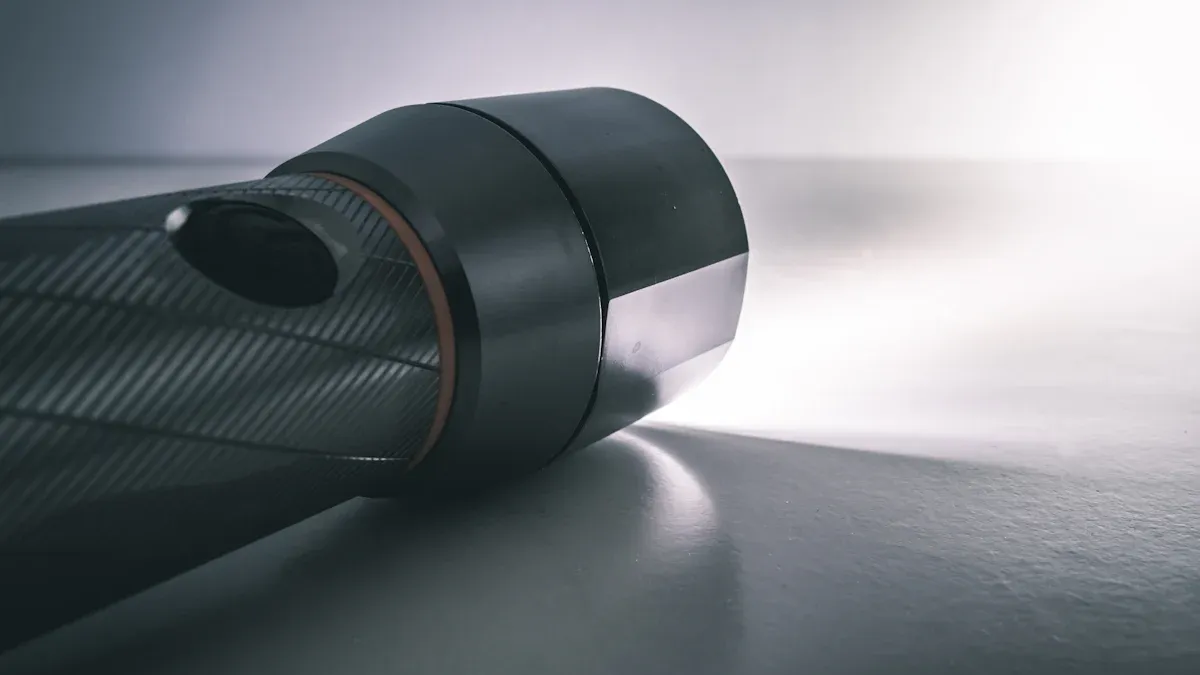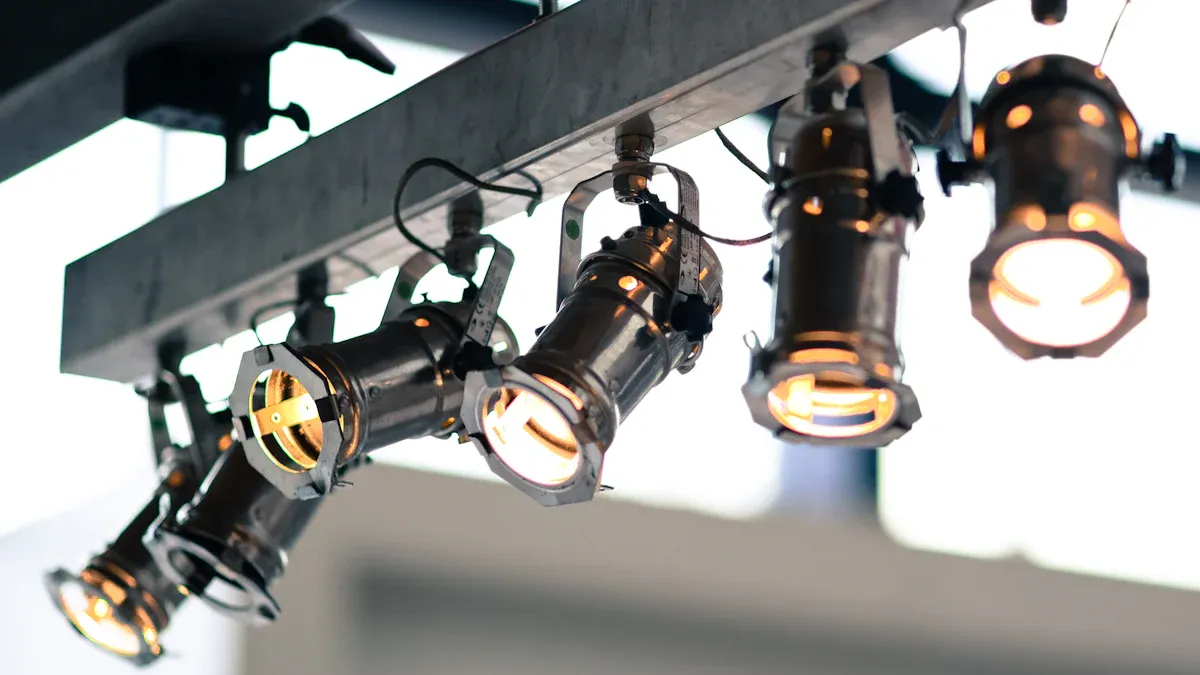
Efficient lighting plays a crucial role in large warehouses and workshops. Long-range flashlights provide targeted illumination, ensuring workers see clearly in dimly lit areas. These flashlights enhance safety by highlighting hazards that fixed warehouse lighting may miss. Their focused beams allow staff to navigate expansive spaces with precision. Unlike traditional lighting solutions, long-range flashlights offer portability, making them ideal for tasks requiring movement or outdoor flashlight applications. By improving visibility and operational efficiency, they become indispensable tools for workshop lighting solutions.
Key Takeaways
- Long-range flashlights help workers see better in dark places.
- They make it easier to spot dangers and avoid accidents.
- These flashlights save energy and don’t need extra wiring.
- Workers can carry them anywhere to handle emergencies fast.
- Taking care of flashlights keeps them working well for longer.
Benefits of Long-Range Flashlights for Warehouse Lighting

Enhanced Visibility in Dimly Lit Areas
Long-range flashlights excel in providing focused illumination, making them ideal for areas with insufficient lighting. Their powerful beams penetrate shadows, ensuring workers can identify objects and navigate spaces with ease. This capability proves especially useful in warehouses where fixed lighting may not reach every corner.
- A study conducted in New York City revealed that improved lighting led to a 7% reduction in overall index crimes, including serious felonies.
- Nighttime crimes saw a 39% decrease after the installation of high-quality LED lighting.
These findings emphasize the importance of light quality in enhancing visibility and safety. By incorporating long-range flashlights into warehouse lighting strategies, businesses can address visibility challenges effectively.
Improved Safety and Hazard Detection
Warehouses often contain potential hazards such as uneven flooring, misplaced tools, or obstructed pathways. Long-range flashlights help workers detect these dangers before accidents occur. Their targeted beams highlight risks that might otherwise go unnoticed under standard lighting conditions.
Improved visibility directly contributes to a safer working environment. Workers equipped with long-range flashlights can identify and avoid hazards, reducing the likelihood of injuries. This proactive approach not only protects employees but also minimizes downtime caused by workplace accidents.
Energy Efficiency and Cost Savings
Long-range flashlights offer significant energy efficiency compared to traditional lighting solutions. Many modern models use LED technology, which consumes less power while delivering brighter light. This efficiency translates into lower energy costs for businesses.
Additionally, the portability of these flashlights eliminates the need for extensive wiring or permanent installations. This flexibility reduces maintenance expenses and allows businesses to allocate resources more effectively. By investing in energy-efficient long-range flashlights, warehouses can achieve better lighting performance while cutting operational costs.
Portability for Flexible Use
Long-range flashlights offer unmatched portability, making them versatile tools for warehouse lighting. Workers can carry these flashlights to any location, ensuring illumination wherever it is needed. Their lightweight design and compact size allow employees to move freely without being encumbered by bulky equipment.
Portability ensures that lighting solutions adapt to the dynamic needs of warehouse operations. Workers can quickly respond to unexpected situations, such as locating misplaced items or inspecting hard-to-reach areas.
Modern flashlights often feature adjustable straps or ergonomic grips, enhancing comfort during prolonged use. Some models include magnetic bases or hooks, enabling hands-free operation in maintenance tasks. These features make portable flashlights indispensable for warehouses with expansive layouts or outdoor storage areas.
- Key Advantages of Portability:
- Easy transportation across large warehouse spaces.
- Quick deployment during emergencies or power outages.
- Flexible use in areas where fixed lighting is impractical.
Portability also supports nighttime operations or low-light conditions. Workers can rely on these flashlights to illuminate specific zones without disrupting the overall lighting setup. This flexibility complements fixed lighting systems, ensuring comprehensive coverage throughout the warehouse.
Practical Applications of Long-Range Flashlights in Warehouses

Locating Items in Hard-to-Reach Areas
Warehouses often store goods in high racks, deep shelves, or remote corners. Long-range flashlights simplify the process of locating items in these challenging spaces. Their powerful beams illuminate areas that fixed lighting systems fail to reach. Workers can quickly identify labels, barcodes, or product details without straining their eyes.
Flashlights with adjustable focus settings allow users to narrow or widen the beam based on the task. For instance, a narrow beam is ideal for pinpointing specific items, while a wider beam provides broader coverage for scanning shelves. This adaptability enhances efficiency during inventory checks or order fulfillment.
Tip: Flashlights equipped with magnetic bases or hooks can be mounted temporarily, freeing workers’ hands for handling items.
By integrating portable lighting tools into warehouse operations, businesses can streamline workflows and reduce the time spent searching for misplaced goods.
Emergency Lighting During Power Outages
Power outages disrupt warehouse operations and compromise safety. Long-range flashlights serve as reliable emergency lighting tools during such incidents. Their bright beams ensure visibility, allowing workers to navigate the space and address urgent tasks.
Emergency response kits often include essential items for power failures. The table below highlights key components:
| Item | Description |
|---|---|
| Emergency Monitoring Kits | Designed for worst-case scenarios in power failures |
| LED Headlamp | Essential for visibility during power outages |
| Pulse Oximeter | Important for monitoring patient health |
Long-range flashlights complement these kits by providing portable, high-intensity lighting. Workers can use them to inspect equipment, guide evacuation routes, or secure valuable inventory. Flashlights with extended battery life are particularly useful during prolonged outages.
Warehouses equipped with these tools can maintain operational continuity and ensure worker safety during emergencies.
Supporting Nighttime or Low-Light Operations
Night shifts and low-light conditions demand reliable lighting solutions. Long-range flashlights enable workers to perform tasks efficiently without relying solely on fixed lighting systems. Their focused beams illuminate specific zones, reducing shadows and enhancing visibility.
These flashlights are especially beneficial for outdoor storage areas or loading docks where permanent lighting may be insufficient. Workers can use them to inspect shipments, verify documentation, or conduct maintenance tasks. Flashlights with ergonomic designs minimize fatigue during extended use, ensuring productivity remains high.
Note: Models with adjustable brightness settings allow workers to customize the light intensity based on the environment.
By incorporating long-range flashlights into nighttime operations, warehouses can optimize lighting and improve overall efficiency.
Assisting in Maintenance and Repairs
Maintenance and repair tasks in warehouses often require precise lighting to identify issues and execute solutions effectively. Long-range flashlights provide the focused illumination necessary for these activities, especially in areas where fixed lighting proves inadequate. Their portability and powerful beams make them indispensable tools for technicians and maintenance crews.
When inspecting equipment, workers frequently encounter tight spaces or elevated platforms. Long-range flashlights with adjustable beams allow them to illuminate specific components, ensuring accurate assessments. For example, a technician repairing a conveyor belt can use a flashlight to pinpoint damaged sections without relying on overhead lights. This targeted approach minimizes errors and speeds up the repair process.
Tip: Flashlights with magnetic bases can be attached to metal surfaces, freeing up both hands for intricate repair work.
In addition to inspections, these flashlights assist in routine maintenance tasks such as checking electrical panels, cleaning machinery, or replacing worn-out parts. Their bright and consistent light ensures workers can identify wear and tear, preventing small issues from escalating into costly problems. Flashlights with extended battery life are particularly useful for prolonged maintenance sessions, reducing interruptions caused by frequent recharging.
Long-range flashlights also enhance safety during repairs. Poor visibility increases the risk of accidents, especially when handling tools or working near hazardous equipment. By providing clear and focused lighting, these devices help workers maintain precision and avoid injuries. This makes them an essential component of any warehouse lighting strategy aimed at improving operational efficiency.
Finally, their durability ensures reliable performance in challenging environments. Many models are designed to withstand dust, moisture, and impact, making them suitable for use in industrial settings. This resilience ensures that maintenance crews can rely on their flashlights even in harsh conditions, ensuring uninterrupted workflow.
Choosing the Best Long-Range Flashlight for Warehouse Lighting
Brightness and Beam Distance
Brightness and beam distance are critical factors when selecting a long-range flashlight for warehouse lighting. Brightness, measured in lumens, determines the intensity of light, while beam distance indicates how far the light can effectively reach. For large warehouses, flashlights with a lumen output of 2000 or more and a beam distance exceeding 1000 feet are ideal.
| Specification | Convoy L21 SFT40 | PowerTac M5-G3 |
|---|---|---|
| Lumen Output | 2300 Lumens | 2030 Lumens |
| Beam Distance | 1600 ft | 1080 ft |
| Candela | 60,000 candela | 29,000 candela |
The Convoy L21 SFT40 offers exceptional beam distance, making it suitable for locating items in high racks or dimly lit corners. The PowerTac M5-G3, while compact, provides multiple brightness modes for versatile use. Both models demonstrate the importance of balancing brightness and beam distance to meet specific warehouse needs.
Tip: Consider flashlights with adjustable focus settings to switch between narrow and wide beams for different tasks.
Durability and Weather Resistance
Warehouses often present challenging environments, requiring flashlights that can withstand rough handling and exposure to dust or moisture. Flashlights adhering to ANSI/PLATO FL1 standards ensure durability through rigorous testing, including drop tests and impact resistance evaluations.
| Standard | Focus | Performance Metrics |
|---|---|---|
| ANSI/PLATO FL1 | Overall flashlight performance | Light output, beam distance, run time |
| IP68 | Dust and water ingress protection | N/A |
Models with IP68 ratings, such as Tektite flashlights, offer superior waterproofing and dust resistance. Features like fully potted bodies and mechanical switches enhance reliability, making these flashlights suitable for harsh warehouse conditions.
Battery Life and Charging Options
Battery performance plays a vital role in ensuring uninterrupted operations. Flashlights powered by lithium-ion batteries provide excellent energy density and runtime, making them ideal for extended use. LiFePO4 batteries, known for their high cycle life and low self-discharge rate, are another reliable option.
| Battery Type | Advantages | Considerations |
|---|---|---|
| Lithium Batteries | Longer runtime, performs well in extreme temperatures, long shelf life | Higher upfront cost |
| Nickel-Metal Hydride (NiMH) | Rechargeable, eco-friendly, reduces waste, saves money over time | Shorter lifespan compared to lithium |
| Lithium-Ion (Li-Ion) | Excellent energy density, runtime, rechargeable | Requires specific chargers |
Flashlights with rechargeable options reduce operational costs and environmental impact. Models with USB-C charging ports or magnetic chargers offer added convenience for warehouse staff.
Note: Always choose flashlights with battery indicators to monitor power levels and avoid unexpected downtime.
Ergonomic Design for Ease of Use
Ergonomic design plays a crucial role in ensuring long-range flashlights are practical and comfortable for warehouse operations. Workers often use these tools for extended periods, making ease of use a top priority. Flashlights with ergonomic features reduce fatigue and improve efficiency during tasks.
A well-designed flashlight typically includes a non-slip grip. This feature ensures secure handling, even in environments where workers may encounter oil, dust, or moisture. Rubberized or textured handles provide additional comfort, allowing users to maintain control during prolonged use. Lightweight construction further enhances usability by minimizing strain on the wrist and arm.
Flashlights with intuitive controls simplify operation. Models with single-button interfaces or easily accessible switches allow workers to adjust brightness settings or switch modes quickly. This functionality proves especially valuable in fast-paced warehouse environments where time is critical.
Adjustable straps or lanyards add convenience by enabling hands-free operation. Workers can secure the flashlight to their wrist or hang it from a belt, ensuring it remains accessible while they perform other tasks. Some designs also feature magnetic bases, allowing the flashlight to attach to metal surfaces for stable, hands-free lighting.
Ergonomic design directly impacts productivity and safety in warehouse lighting. Workers equipped with user-friendly flashlights can focus on their tasks without discomfort or distraction. By prioritizing ergonomics, businesses can enhance operational efficiency and create a more comfortable working environment.
Tip: When selecting a flashlight, consider models tested for ergonomic performance to ensure they meet the demands of warehouse operations.
Tips for Using Long-Range Flashlights Effectively in Warehouses
Regular Maintenance and Cleaning
Routine maintenance ensures long-range flashlights perform reliably in demanding warehouse environments. Workers should clean the flashlight lens regularly to remove dust or debris that can obstruct light output. Using a soft, lint-free cloth prevents scratches on the lens surface. Battery compartments should also be inspected for corrosion or leakage, as these issues can compromise performance.
Tip: Replace batteries promptly when they show signs of wear to avoid sudden power loss during critical tasks.
Additionally, checking for loose connections or damaged components helps identify potential issues early. Flashlights with replaceable parts allow for quick repairs, extending their lifespan and reducing downtime.
Proper Storage to Maximize Lifespan
Proper storage practices play a vital role in preserving the functionality of long-range flashlights. Batteries should be removed from flashlights when not in use for extended periods to prevent leakage. Storing flashlights in a cool, dry place minimizes exposure to moisture and extreme temperatures, which can degrade internal components.
- Best Practices for Storage:
- Inspect battery stock regularly for damage, corrosion, or leakage.
- Use First-In, First-Out (FIFO) practices to ensure older batteries are used first.
- Conduct routine checks to maintain battery integrity before use.
Organized storage systems, such as wall-mounted racks or labeled compartments, make flashlights easily accessible during emergencies. This approach enhances efficiency and ensures workers can quickly locate tools when needed.
Training Staff for Safe and Efficient Use
Training employees on the proper use of long-range flashlights enhances safety and operational efficiency. Workers should understand how to adjust brightness settings and beam focus for different tasks. Demonstrating safe handling techniques, such as securing the flashlight with a wrist strap, reduces the risk of accidental drops.
Note: Training sessions should emphasize the importance of inspecting flashlights before use to ensure they are fully functional.
Providing hands-on practice allows employees to familiarize themselves with flashlight features, such as magnetic bases or adjustable grips. This preparation ensures workers can respond effectively to various warehouse lighting needs, from locating items to addressing emergencies.
Combining Flashlights with Fixed Lighting Solutions
Integrating long-range flashlights with fixed lighting systems creates a comprehensive warehouse lighting strategy. Fixed lighting provides consistent illumination across large areas, while flashlights offer targeted lighting for specific tasks. Together, they enhance visibility and operational efficiency in warehouse environments.
Fixed lighting systems often struggle to illuminate hard-to-reach areas, such as high shelves or narrow aisles. Workers can use long-range flashlights to supplement these systems by focusing light on specific zones. For example, during inventory checks, flashlights help employees locate items in dimly lit corners that fixed lights cannot adequately cover. This combination ensures no area remains overlooked.
Emergency situations highlight the importance of this integration. Power outages can render fixed lighting systems inoperable, leaving workers in the dark. Long-range flashlights act as reliable backup tools, ensuring operations continue without disruption. Flashlights with extended battery life and high lumen output are particularly effective in these scenarios.
Combining these two lighting solutions also improves safety. Fixed lighting reduces general shadows, while flashlights allow workers to inspect potential hazards closely. This dual approach minimizes risks and creates a safer working environment. For maintenance tasks, flashlights provide the precision needed to identify and resolve issues that fixed lighting might miss.
To maximize the benefits of this integration, businesses should train staff to use both lighting solutions effectively. Workers should understand when to rely on fixed lighting and when to deploy flashlights for additional support. By combining these tools, warehouses can achieve optimal lighting performance and improve overall productivity.
Tip: Regularly evaluate the performance of both fixed lighting systems and flashlights to ensure they meet the dynamic needs of warehouse operations.
Long-range flashlights transform warehouse lighting by delivering targeted illumination that enhances visibility and safety. Their portability simplifies navigation and inventory management in expansive spaces. Models like the LEP Lights W50, with ultra-long distance illumination reaching up to 4 kilometers, demonstrate their effectiveness in improving operational efficiency. Features such as intuitive controls and heat reduction systems further optimize performance.
Selecting durable flashlights with extended battery life ensures reliability during critical tasks. Regular maintenance and proper storage maximize their lifespan. Businesses should evaluate their lighting setup and integrate long-range flashlights to address gaps in coverage and improve overall productivity.
Tip: Combining portable flashlights with fixed lighting systems creates a comprehensive solution for large warehouse environments.
Post time: May-06-2025
